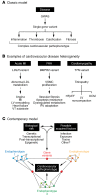The application of big data to cardiovascular disease: paths to precision medicine
- PMID: 31895052
- PMCID: PMC6934200
- DOI: 10.1172/JCI129203
The application of big data to cardiovascular disease: paths to precision medicine
Abstract
Advanced phenotyping of cardiovascular diseases has evolved with the application of high-resolution omics screening to populations enrolled in large-scale observational and clinical trials. This strategy has revealed that considerable heterogeneity exists at the genotype, endophenotype, and clinical phenotype levels in cardiovascular diseases, a feature of the most common diseases that has not been elucidated by conventional reductionism. In this discussion, we address genomic context and (endo)phenotypic heterogeneity, and examine commonly encountered cardiovascular diseases to illustrate the genotypic underpinnings of (endo)phenotypic diversity. We highlight the existing challenges in cardiovascular disease genotyping and phenotyping that can be addressed by the integration of big data and interpreted using novel analytical methodologies (network analysis). Precision cardiovascular medicine will only be broadly applied to cardiovascular patients once this comprehensive data set is subjected to unique, integrative analytical strategies that accommodate molecular and clinical heterogeneity rather than ignore or reduce it.
Conflict of interest statement
Figures



References
-
- van der Ende MY, Said MA, van Veldhuisen DJ, Verweij N, van der Harst P. Genome-wide studies of heart failure and endophenotypes: lessons learned and future directions. Cardiovasc Res. 2018;114(9):1209–1225. - PubMed

